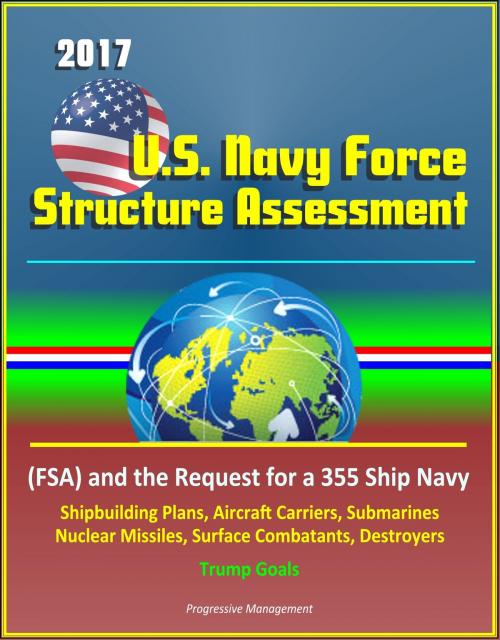2017 U.S. Navy Force Structure Assessment (FSA) and the Request for a 355 Ship Navy, Shipbuilding Plans, Aircraft Carriers, Submarines, Nuclear Missiles, Surface Combatants, Destroyers, Trump Goals
Nonfiction, History, Military, Nuclear Warfare, Naval| Author: | Progressive Management | ISBN: | 9781370566617 |
| Publisher: | Progressive Management | Publication: | August 27, 2017 |
| Imprint: | Smashwords Edition | Language: | English |
| Author: | Progressive Management |
| ISBN: | 9781370566617 |
| Publisher: | Progressive Management |
| Publication: | August 27, 2017 |
| Imprint: | Smashwords Edition |
| Language: | English |
Navy's Force Structure Assessment (FSA) was developed in an effort to determine the right balance of existing forces, the ships we currently have under construction and the future procurement plans needed to address the ever-evolving and increasingly complex threats the Navy is required to counter in the global maritime commons. This FSA assumes that the future plans for our Navy, in ship types and numbers of ships, continues to replace the ships we have today with ships of similar capability and in similar numbers as we transition to the future Navy - it does not address potential options that may come out of the ongoing review of the potential Future Fleet Architecture studies that were directed by Congress and completed in October 2016. As we evaluate the options presented in these studies and move to include them in our plans for tomorrow's Navy, this FSA will need to be updated to reflect those changes that are determined to be most beneficial to meeting the Navy's missions of the future.
The FSA, released at the end of 2016 by the outgoing Obama administration, recommends a 355-ship fleet including 12 carriers, 104 large surface combatants, 52 small surface combatants, 38 amphibious ships, and 66 submarines. The assessment will be one input to the Navy's FY-2018 30-year shipbuilding plan. The current proposed Navy budget is seen as a bridge to this larger Navy, with shipbuilding on an upward glide slope towards 308 ships.
Navy leadership is confident that, if funded, this plan is executable, as each ship class called for in the FSA has an active shipbuilding line already up and running.
"To continue to protect America and defend our strategic interests around the world, all while continuing the counter terrorism fight and appropriately competing with a growing China and resurgent Russia, our Navy must continue to grow," said Secretary of the Navy Ray Mabus. "All of the analysis done to date, inside and outside of the Navy, recognizes, as we have for nearly the last eight years, the need for a larger Fleet. That is why, working with Congress and our partners in industry, we have successfully reversed the decline in shipbuilding that occurred from 2001-2009, putting 86 ships under contract over the last seven years. Maintaining this momentum, and the cost-saving business practices we have established, will be critical to ensuring the Navy is able to achieve the FSA-recommended fleet size and is positioned to maintain the global presence the Navy and Marine Corps uniquely provide our nation."
Part of this reproduction includes the Congressional Research Service report on the FSA and shipbuilding. This report presents background information and issues for Congress concerning the Navy's force structure and shipbuilding plans. The current and planned size and composition of the Navy, the rate of Navy ship procurement, and the prospective affordability of the Navy's shipbuilding plans have been oversight matters for the congressional defense committees for many years. The Navy's proposed FY2018 budget, as amended on May 24, 2017, requests the procurement of nine new ships, including one Gerald R. Ford (CVN-78) class aircraft carrier, two Virginia-class attack submarines, two DDG-51 class destroyers, two Littoral Combat Ships (LCSs), one TAO-205 class oiler, and one towing, salvage, and rescue ship. On December 15, 2016, the Navy released a new force-structure goal that calls for achieving and maintaining a fleet of 355 ships of certain types and numbers. The issue for Congress is whether to approve, reject, or modify the Navy's force structure and shipbuilding plans. Decisions that Congress makes on this issue can substantially affect Navy capabilities and funding requirements, and the U.S. shipbuilding industrial base.
Navy's Force Structure Assessment (FSA) was developed in an effort to determine the right balance of existing forces, the ships we currently have under construction and the future procurement plans needed to address the ever-evolving and increasingly complex threats the Navy is required to counter in the global maritime commons. This FSA assumes that the future plans for our Navy, in ship types and numbers of ships, continues to replace the ships we have today with ships of similar capability and in similar numbers as we transition to the future Navy - it does not address potential options that may come out of the ongoing review of the potential Future Fleet Architecture studies that were directed by Congress and completed in October 2016. As we evaluate the options presented in these studies and move to include them in our plans for tomorrow's Navy, this FSA will need to be updated to reflect those changes that are determined to be most beneficial to meeting the Navy's missions of the future.
The FSA, released at the end of 2016 by the outgoing Obama administration, recommends a 355-ship fleet including 12 carriers, 104 large surface combatants, 52 small surface combatants, 38 amphibious ships, and 66 submarines. The assessment will be one input to the Navy's FY-2018 30-year shipbuilding plan. The current proposed Navy budget is seen as a bridge to this larger Navy, with shipbuilding on an upward glide slope towards 308 ships.
Navy leadership is confident that, if funded, this plan is executable, as each ship class called for in the FSA has an active shipbuilding line already up and running.
"To continue to protect America and defend our strategic interests around the world, all while continuing the counter terrorism fight and appropriately competing with a growing China and resurgent Russia, our Navy must continue to grow," said Secretary of the Navy Ray Mabus. "All of the analysis done to date, inside and outside of the Navy, recognizes, as we have for nearly the last eight years, the need for a larger Fleet. That is why, working with Congress and our partners in industry, we have successfully reversed the decline in shipbuilding that occurred from 2001-2009, putting 86 ships under contract over the last seven years. Maintaining this momentum, and the cost-saving business practices we have established, will be critical to ensuring the Navy is able to achieve the FSA-recommended fleet size and is positioned to maintain the global presence the Navy and Marine Corps uniquely provide our nation."
Part of this reproduction includes the Congressional Research Service report on the FSA and shipbuilding. This report presents background information and issues for Congress concerning the Navy's force structure and shipbuilding plans. The current and planned size and composition of the Navy, the rate of Navy ship procurement, and the prospective affordability of the Navy's shipbuilding plans have been oversight matters for the congressional defense committees for many years. The Navy's proposed FY2018 budget, as amended on May 24, 2017, requests the procurement of nine new ships, including one Gerald R. Ford (CVN-78) class aircraft carrier, two Virginia-class attack submarines, two DDG-51 class destroyers, two Littoral Combat Ships (LCSs), one TAO-205 class oiler, and one towing, salvage, and rescue ship. On December 15, 2016, the Navy released a new force-structure goal that calls for achieving and maintaining a fleet of 355 ships of certain types and numbers. The issue for Congress is whether to approve, reject, or modify the Navy's force structure and shipbuilding plans. Decisions that Congress makes on this issue can substantially affect Navy capabilities and funding requirements, and the U.S. shipbuilding industrial base.















